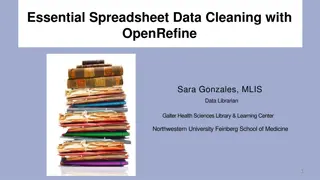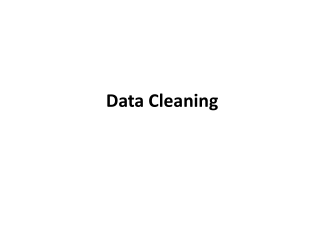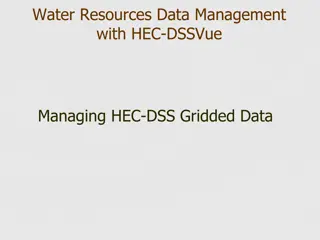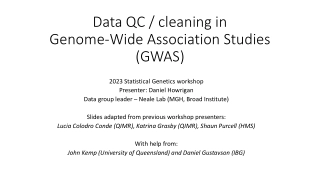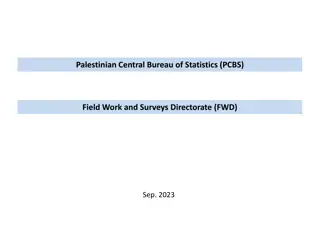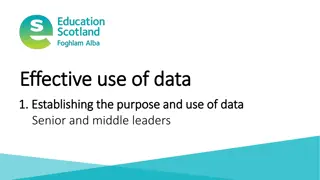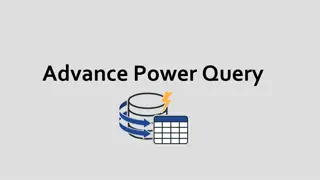
Simplified Data Manipulation and Cleaning Without Coding
To fully experience and leverage the potential of your data, complex coding is not always the best bet. Business users and analysts can increase their productivity by leaving everyday challenges at bay. Our latest blog explores how no-code Business Intelligence tools are revolutionizing data manipulation and cleaning, making it accessible to everyone, from business users to data analysts. Discover how these innovative tools simplify data tasks, enhance accuracy, and take a more intelligent approach towards business decisions. Dive into the future of data management and see how Growu2019s No-code
Download Presentation
Please find below an Image/Link to download the presentation.
The content on the website is provided AS IS for your information and personal use only. It may not be sold, licensed, or shared on other websites without obtaining consent from the author. Download presentation by click this link. If you encounter any issues during the download, it is possible that the publisher has removed the file from their server.
Presentation Transcript
Simplified Data Manipulation and Cleaning Without Coding What does Traditional Data Manipulation lack? The traditional data manipulation techniques require the writing of complicated codes in languages such as SQL, Python, or R. As much as these techniques are pretty accurate and extensive in their output, they require a level of technical skill and experience that may be missing from most business users. This dependence on extremely hard-to-understand and use tools results in issues such as delays, inefficiencies, and high expenses as organizations have to source technical skills or depend on the IT staff. The Emergence of No-Code Business Intelligence Tools Due to the growing need for easy data manipulation, no-code Business Intelligence (BI) tools have emerged. Most of these tools are developed to be easy to use to enable non-technical users to perform data tasks easily. No-code BI software allows business users to do complicated operations on data without coding. This democratization of data access enables the teams to work more autonomously and effectively. Key Features of No-Code Data Manipulation Tools Data has become a critical tool that is used by the management of firms to make vital decisions. However, the traditional approaches to data manipulation are often quite complex and demand extensive coding skills, which poses a challenge to many business users. This has resulted in the development of no-code BI tools that aim at easing data manipulation for the general population. 1. User-Friendly Interface Another major benefit of no-code Business Intelligence tools is the ease of use of their application. While converting data and performing manipulations, it is necessary to code, while no-code BI tools have a convenient and graphic interface. These interfaces employ
drag-and-drop features, and the users can easily accomplish complex data operations without coding. This simplicity allows business users, data analysts, and BI professionals to work on data analysis instead of fighting with the details. 2. Drag-and-Drop Functionality Drag-and-drop is one of the key features of no-code BI software. It enables users to manipulate data on the dashboards by using tools such as drag-and-drop. For instance, it is possible to merge datasets, sort data, and build visualizations with the help of simple drag-and-drop functions. This functionality minimizes the amount of time and effort needed in data manipulation to levels that can be easily managed by users with little or no programming experience. 3. Pre-Built Functions and Templates No-code BI tools are ready with numerous functions and templates that help users to transform the data without coding skills. These include filtering of data, sorting of data, merging of data and also removing duplicate data(known as deduplication). These functions are pre-built in such a way that users don t need to write scripts for cleaning and transforming their data. This feature is not only time-saving but also ensures the data manipulation procedures have greater uniformity and reliability. 4. Automated Data Cleaning For any organization working with data, maintaining its quality is the biggest challenge of all. And, how do we achieve that without adding significant cost overburden to the existing pile? No-code BI software has pre-built data cleaning tools that are used to detect and correct problems with data, including missing values, duplicated entries, and format inconsistencies. These automated processes improve the quality of data, which makes it more accurate and, therefore, more valuable. 5. Real-Time Data Processing It is always good to have data-backed decisions that form the basis of a larger planning and strategy. Real-time data processing provides the most up-to-date data, which is useful in analyzing trends or anomalies.
No-code Business Intelligence tools enable users to process data in real-time, which means that the data is analyzed as it is produced. This real-time processing allows businesses to make decisions when the information is fresh and this puts the business in a favorable position in the market. 6. Interoperability with Other Data Sources No-code BI tools are developed to work with different data sources, such as databases, cloud storage, and third-party applications. This integration capability enables businesses to pull data from various sources into one place for analysis. Since the data is collected from various sources, businesses get a holistic understanding of their operations hence improving their decision-making. 7. Customizable Dashboards and Reports Customization is another key feature of no-code BI software. Users can create personalized dashboards and reports that meet their specific needs. These customizable dashboards can display key performance indicators and visualizations that are relevant to different stakeholders within the organization. The ability to tailor dashboards and reports ensures that users can quickly access the insights they need to drive business performance. 8. Collaboration and Sharing Collaboration is vital in any data-driven organization. These no-code BI tools facilitate collaboration by allowing users to share dashboards, reports, and data insights with team members and stakeholders. This sharing capability ensures that everyone in the organization has access to the same information, fostering a collaborative environment and promoting data-driven decision-making. 9. Security and Compliance Nothing is more costlier than the data security and compliance concerns for any business. No-code BI tools host a series of robust security features, including data encryption, user authentication, and access controls. These features ensure that sensitive data is protected and that businesses comply with relevant data protection regulations. By providing a secure environment for data manipulation and analysis, no-code BI tools help businesses safeguard their valuable data assets.
Step-by-Step Guide to Using No-Code Tools for Data Cleaning Since data cleaning can be pretty challenging for those without any technical background, let s examine each step in greater detail using no-code BI tools. Step 1: Initial Data Import The first step in using no-code BI tools for data cleaning is to import your data. These tools support a variety of data sources, including spreadsheets, databases, and cloud storage. Connecting to Data Sources: No-code BI software typically offers a simple interface to connect to different data sources. For instance, you can import data directly from Google Sheets, Excel files, or databases like MySQL and PostgreSQL. This connectivity is achieved through built-in connectors that facilitate seamless data transfer. Data Preview: Once connected, these tools allow you to preview the data, providing an overview of its structure and content. This preview helps you identify any obvious issues, such as missing values or incorrect formats, right from the start. Advanced previews might include data profiling statistics and initial quality assessments. Step 2: Data Profiling Data profiling is an essential step to understanding the characteristics and quality of your data. Assessing Data Quality: No-code Business Intelligence tools offer data profiling features that automatically evaluate the quality of your data. They bring attention to anomalies such as missing values, duplicate records, and inconsistent data types. Profiling often includes metrics like null value counts, data type distributions, and outlier detection. Generating Summary Statistics: These tools can create summary statistics, such as mean, median, and standard deviation for numerical data, and frequency distribution for categorical data. These statistical inferences can help you gain insights into the overall quality and distribution of your dataset. Additionally, some tools offer visual summaries, such as histograms and pie charts, for a more intuitive understanding. Step 3: Data Cleaning and Transformation This step involves using the built-in functionalities of no-code BI tools to clean and transform your data. Handling Missing Values: No-code BI software provides options to handle missing values, such as filling them with mean, median, or mode values, or using more advanced imputation techniques. Alternatively, you can choose to remove rows or columns with
excessive missing data. Advanced options might include machine learning-based imputations that predict missing values based on existing data patterns. Removing Duplicates: Duplicate records can skew your analysis. No-code BI tools offer easy-to-use functions to identify and remove duplicates, ensuring the integrity of your dataset. These functions typically use unique identifiers or composite keys to detect duplications accurately. Standardizing Data Formats: Consistent data formats are crucial for analysis. These tools enable you to standardize date formats, numerical precision, and text capitalization with a few clicks, ensuring uniformity across your dataset. Features might include automatic date parsing and format conversions, as well as bulk text transformations. Data Transformation: You can apply various transformations, such as filtering, sorting, and aggregating data, using the drag-and-drop functionality. For example, you might want to filter out entries that fall outside a certain date range or group data by specific categories for deeper analysis. Advanced transformations can include pivoting data, creating calculated fields, and joining multiple datasets. Step 4: Data Validation After cleaning and transforming your data, it s essential to validate the changes to ensure accuracy. Reviewing Changes: No-code Business Intelligence tools provide a detailed log of all changes made during the cleaning process. Reviewing this log helps verify that the intended modifications have been applied correctly. Tools often offer a side-by-side comparison feature to see the original versus the cleaned data. Cross-Checking with Source Data: It s good practice to cross-check a sample of the cleaned data against the original source to ensure no critical information has been lost or altered incorrectly. Automated validation rules can be set up to periodically check data consistency against source data. Step 5: Exporting Cleaned Data Once the data is cleaned and validated, the final step is to export it for further analysis or reporting. Export Options: No-code BI tools offer multiple export options, allowing you to save the cleaned data in various formats such as CSV, Excel, or even back into a database. This flexibility ensures compatibility with your preferred analysis tools. Some tools also offer APIs for automated data export to other applications.
Integration with BI Platforms: Many no-code BI software solutions integrate seamlessly with other Business Intelligence platforms, enabling you to directly load the cleaned data into your BI dashboards for real-time analysis. Integration capabilities often include connectors to popular BI tools like Tableau, Power BI, and Grow BI. Conclusion The ability to manipulate and clean data without coding is a game-changer. No-code Business Intelligence tools have democratized data access, empowering business users, data analysts, and BI professionals to transform raw data into actionable insights effortlessly. Eliminate the complexities of traditional data manipulation methods using these tools, save hundreds of coding hours and reduce burgeoning costs but also enhance the accuracy and reliability of data-driven decisions. Grow BI stands at the vanguard of this revolution, offering a robust, user-friendly platform designed to make data manipulation and cleaning as simple as possible. With Grow BI, you can seamlessly import, profile, clean, and transform your data, all through an intuitive interface that requires no coding skills. This means you can focus on what truly matters analyzing data to drive business success. Want to witness the power of no-code BI software in action? Start your journey into the BI world with added confidence with a 14-day free trial. Experience firsthand how easy it is to clean and manipulate your data without writing a single line of code. If you can't believe us, check out the Grow data dashboard reviews on TrustRadius and see why over 20,000 businesses like yours are choosing Grow BI to streamline their data processes. Transform how you treat your data and get away with innumerable benefits. Original Source: https://bit.ly/3zmWeLA

